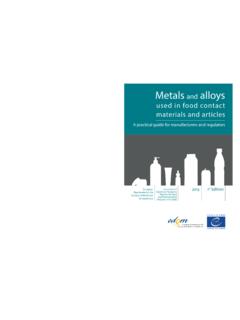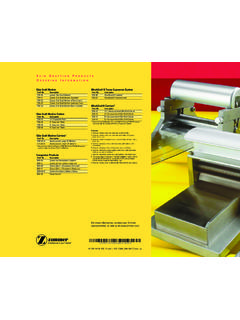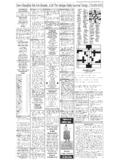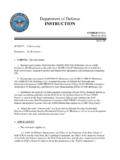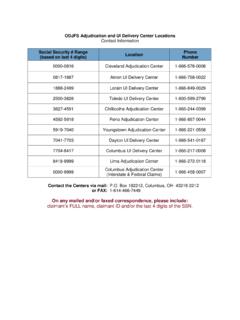Transcription of CHROMIUM, HEXAVALENT, 7703 by Field-Portable …
1 NIOSH Manual of Analytical Methods (NMAM), Fourth EditionCHROMIUM, HEXAVALENT, 7703 by Field-Portable SpectrophotometryCr[VI] MW: (Cr) (CrO3)CAS: 18540-29-9 RTECS: GB6262000 METHOD: 7703, Issue 1 EVALUATION: FULLI ssue 1: 15 March 2003 OSHA : C mg/m3 (as CrO3) mg/m3/10 h (carcinogen)ACGIH: mg/m3 (water-soluble compounds); mg/m3 (insoluble compounds)PROPERTIES:oxidizing agentSYNONYMS: vary depending on the compound; chromate commonly usedSAMPLINGMEASUREMENTSAMPLER:FILTER ( m PVC membrane [1,2]; m MCE or m PTFE acceptablefor field analysis [3]).FLOW RATE:1 to 4 L/minVOL-MIN:10 L (2 L/min for 5 min) -MAX:1200 L (2 L/min for 600 min)SHIPMENT:refrigerant pack at 4 2 oC (optional)SAMPLESTABILITY:analyze within 24 hours; if applicable,keep samples at 4 2 :One per twenty field samples, minimumof 2 per : Field-Portable VISIBLESPECTROPHOTOMETRYANALYTE:Cr[VI] - diphenylcarbazone complexEXTRACTION:10 mL M (NH4)2SO4 / M NH4OH (pH = 8 + ), ultrasonic extraction 30min Cr[VI]ISOLATION:Strong anion exchange solid phaseextraction M (NH4)2SO4 / M NH4 OHWAVELENGTH:540 nm, 1-cm path lengthCALIBRATION:standard solutions of K2 CrO4 M (NH4)2SO4 / M NH4 OHRANGE:1 to 400 g per sampleESTIMATED g Cr[VI] per sample [3]PRECISION ( r) @ 3 to 400 g per sample [3]ACCURACYRANGE to 1146 g/m3(~20 to ~200-L samples) [3, 4] [3]OVERALL PRECISION ( rT) :+ : The working range is (at least) to 1000 g/m3 for a 200 to 500-L air sample.
2 This method may be usedfor the determination of soluble forms of Cr[VI]. Insoluble Cr[VI] requires modification of the method using ultrasonic extractionwith carbonate : Interferences from reducing agents such as Fe2+ are minimized to the extent possible by the alkalineultrasonic and solid phase extraction procedures. Interferences from other metal cations are eliminated by solid phaseextraction [5]. Some reduction can occur on the filter during sampling, and is usually due to the presence of Fe2+, organicmaterial, and/ or acidic conditions [6]. Reduction of Cr[VI] can occur over time on any filter type, and is especially problematicon MCE filters [7]. However, the use of MCE and PTFE filters has been found to be acceptable for field use, whereperformance has been found to be equivalent to that of PVC filters [3]. During ultrasonic extraction, oxidation of Cr[III] insolution to Cr[VI] is prevented by the use of an ammonium buffer [8].
3 OTHER METHODS: This method is designed to be used in the field , but can also be utilized in the fixed-site laboratory. It is analternative to laboratory methods such as NIOSH method 7605 or OSHA method ID-215 (hot plate digestion and ionchromatography). NIOSH method 7600 is a similar procedure, but no separation step is used. A field method not involving aCr[VI] isolation step, MDHS method 61, has been promulgated by the British Health and Safety Executive [9].CHROMIUM, HEXAVALENT by portable VIS: METHOD 7703, Issue 1, dated 15 March 2003 - page 2 of 5 NIOSH Manual of Analytical Methods (NMAM), Fourth EditionREAGENTS: sulfate, reagent grade. hydroxide, reagent grade. , distilled or deionized. acid (37%), reagent grade. , reagent grade.* ,5-Diphenylcarbizide (DPC), reagent grade. , reagent grade. solution (extraction buffer): M(NH4)2SO4 / M NH4OH, 1 L, aqueous indistilled or deionized :Modification of method by usingcarbonate buffer ( , sodiumcarbonate) is required for extractionof insoluble Cr[VI].
4 Solution (elution buffer): M(NH4)2SO4 / M NH4OH, 250 mL, indistilled or deionized (VI) standard (as potassium chromate),*1000 stock solution, 100 g/mL: Dilute 1000 g/mL Cr(VI) standard 1:10 withextraction buffer. (Solution is stable for amonth.) complexation solution(20 mM): Measure g DPC powder andplace in a 100-mL volumetric flask. Add~80 mL of acetonitrile and dissolve the DPC. Bring up to the mark with additionalacetonitrile and mix thoroughly. * See SPECIAL PRECAUTIONSEQUIPMENT: : 5- m pore size polyvinylchloride(PVC), m pore size mixed cellulose ester(MCE), or m polytetrafluoroethylene (PTFE)filters, 37-mm diameter, with backup pads, inpolystyrene cassette filter holder, 2- or :MCE filters, and some PVC filters,promote reduction of Cr[VI] on atimescale of a few days. However, eitherfilter type is acceptable for field use if thesamples are to be analyzed within 24 hof collection.
5 Sampling pump, 1 to 4 L/min, withflexible connecting tubing. bath (sonicator), 100 W minimumpower. phase extraction manifold, 12- or 24-port. vacuum pump with pressure meteringvalve. visible spectrophotometer, sample pathlength 1 cm with Quartz cuvette(s). anion exchange solid phase extraction(SPE) cartridges, 10-mL, disposable; loaded with500 or 1000 mg quaternary amine bonded silica,capacity ~1 meq/g. , mechanical, assorted volumes ( , 1to 10 mL) with disposable tips. , mechanical, assorted volumes( , 10 to 100 L) with disposable tubes, plastic, 15-mL, with vials, 20-mL, glass, with PTFE-linedscrew beakers (and possibly Erlenmeyerflasks), various flasks, 25-, 100-, 250-, and , or plastic gloves, plastic or power generator (if necessary).NOTE:If no power supply is available at thefield site, electric power can be providedby means of a portable , gasoline (orother) generator.
6 SPECIAL PRECAUTIONS: Hexavalent chromium is a human respiratory carcinogen [10]. Effortsmust be made to prevent aerosolizing chromate-containing compounds and solutions. All samplepreparation should be carried out in a well-ventilated area (vacuum hood preferable); forced ventilationshould be used if no hood is available. Acetonitrile solutions are flammable must be handled carefully, , wearing of impermeable gloves, and avoidance of vapors. To the extent possible, solutions shouldbe prepared in the laboratory before taking them to the , HEXAVALENT by portable VIS: METHOD 7703, Issue 1, dated 15 March 2003 - page 3 of 5 NIOSH Manual of Analytical Methods (NMAM), Fourth EditionSAMPLING: each personal sampling pump with a representative sampler in line. at an accurately known flow rate in the range of 1 to 4 L/min for a sample size of 100 to1000 L. Do not exceed 2 mg of particulate loading on the filter.
7 Label the filter cassette. a fresh pair of disposable plastic or latex gloves (to prevent sample contamination). PTFE-coated forceps, remove filters from cassettes after of completion of sampling, and placein separate plastic 15-mL centrifuge tubes for subsequent sample preparation. Discard cellulosebackup pads and PREPARATION: 10 mL of extraction solution (weak buffer) to each 15-mL centrifuge tube containing the filtersample. Ensure that the filter is covered by the extraction solution. If necessary, push the filter downwith a clean glass or plastic rod to immerse the entire filter. Cap and label the tubes. sample tubes in the ultrasonic bath (sonicator). The water level in the bath should be higherthan the liquid level in the centrifuge tube. Sonicate for 30 :Numerous centrifuge tubes containing sample filters can be subjected to sonication at onetime, depending upon the size of the ultrasonic bath.
8 Ensure that the bath is warm (but <40oC). 7. Set up the solid phase extraction disposable solid phase extraction (SPE) cartridges in each port, and place scintillation vialsbeneath the cartridges. Label the the vacuum pump to the SPE condition SPE cartridges, pipet 3 mL of methanol into each cartridge, and evacuate. Thenpipet 3 mL of extraction solution into each cartridge, and evacuate. Repeat. Cr[VI] from sample 3 to 5 mL of each ultrasonicated sample solution from the centrifuge tubes into thedisposable SPE cartridge. Dispose of the pipet tip. the vacuum to obtain an extraction rate of about one drop per second (approximately 8"Hg; no more than 10" Hg). Manually tighten cartridges by twisting, if necessary, to slow down therate of liquid 1:For samples in the which the expected Cr[VI] concentration is high, smaller aliquots (1to 2 mL) should be dispensed into the SPE cartridges to prevent breakthrough.
9 Highconcentration of Cr[VI] can be assessed visually by its orange color. NOTE 2:For samples having low Cr[VI] concentration, additional 3 to 5 mL aliquots ofultrasonicated sample solution can be loaded onto SPE cartridges (step ). In thismanner, the cartridge can be used to preconcentrate Cr[VI]. it appears the solution has passed through all the cartridges, increase the vacuum toensure that all solution passes through the cartridges. This step selectively binds Cr[VI] to thestationary phase of each remove residue of Cr[III] and other potential interferences, turn the vacuum down (by turningcounterclockwise) to 0" Hg. Add 1 mL distilled or deionized water to each cartridge, adjustvacuum to 1 drop per second (~8" Hg), then reduce to 0" when completed. the scintillation vials beneath the cartridges and : This solution contains unwanted fractions that should contain no Cr[VI].
10 Clean, labeled scintillation vials beneath correct cartridges in the SPE 9 mL of the elution solution (elution buffer) to each cartridge to elute Cr[VI], and repeat through the scintillation vials, and cap them. Dispose of the used SPE :The scintillation vials now contain extracted and isolated Cr[VI], which is ready forsubsequent analysis. each scintillation vial containing extracted and isolated Cr[VI], and add 100 L Hcl. 2 mL DPC complexation solution, recap vials, and mix thoroughly. Allow to stand for at least 5min for complete color , HEXAVALENT by portable VIS: METHOD 7703, Issue 1, dated 15 March 2003 - page 4 of 5 NIOSH Manual of Analytical Methods (NMAM), Fourth EditionCALIBRATION AND QUALITY CONTROL: daily with at least 6 working standards over the range of 0 to 2 g/mL of Cr[VI] 10-mL volumetric flasks containing ~5 mL of elution solution (strong buffer), pipet knownvolumes (20 to 300 L) of Cr[VI] calibration stock solution (100 g/mL) to produce concentrationsof , , , , and g/mL.










